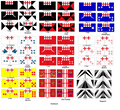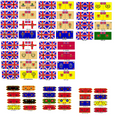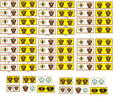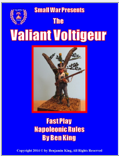 Loading... Please wait...
Loading... Please wait...Categories
- Ben Kings Rules
- Blitzkreig Miniatures
- Civil War Scenario Books
- ESR System
- Hayland Terrain Wargames
- Land
- WWII Posters 15mm / 25mm
- Napoleonic Scenario Books
- Flags-a
- Great Battles with Flags
- Metal Base Moving Stands
- GREAT DEALS!
- Painting Army Books
- Victrix Products
- 10mm Miniature Flags
- Artizen Design Miniatures
- Bad Squiddo Games - Female Miniatures
- SAGA / Gripping Beast
- Warload Games
- Download Catalog
New Products
Our Newsletter
- Home
- Ben Kings Rules
- SWS-07 Valiant Voltigeurs
- Home
- Ben Kings Rules
- Land
- SWS-07 Valiant Voltigeurs
Product Description
Also avaiable in Digital Form
Small War Presents
The Valiant Voltigeur
An Ultra-Fast Set of Napoleonic Rules
By Ben King
Introduction: In the early years of miniature wargaming most Napoleonic rules were short, simple and easy to play, but many of them failed to address the realities of Napoleonic warfare. The Valiant Voltigeur recaptures the spirit of those short, fun-filled rules while maintaining the accuracies that today’s wargamers expect. On the next 2 ½ pages is a set of rules for Napoleonic tactical combat. After the rules are combat examples and the Combat Cards with the tables needed to play Valiant Voltigeur. As long as the scales of the figures and the basing systems are consistent they’ll work with these rules. That’s it.
Preliminaries: You will need model soldiers, terrain, a tape measure and 2 differently colored 10 sided dice. One d10 has a range of 1-10. 2 d10s are d% and give a range of 1-100. Soldier classes are Guard, Elite, Veteran, Line and Green. Class differences are demonstrated by d10 modifiers for combat and morale, the Unit Reaction Time (URT) and fatigue points listed in the Class Mod Table on Combat Card A.
The Game Turn: The game is divided into turns and each turn has 4 parts. Part 1 is movement and fire. Each side rolls d% and the high scorer must move first. After the high scorer (player 1) moves, any eligible artillery piece or unit on either side may fire. Artillery always fires first. After player 2 moves, remaining eligible guns/units may fire. Guns and units can fire only once per turn. Part 2 is Melee (hand-to-hand combat). Part 3 is unit Morale and Part 4 is Army morale. Casualties are removed as they occur.
Movement is in inches. The maximum movement rates are listed in the Movement Table. Players may move their units shorter distances if they wish or not at all. Formed infantry and cavalry are allowed to charge every 4th move but only to engage the enemy. Light infantry and light cavalry in skirmish formation may run every 4th move. A URT is the time it takes the unit to accomplish something. For example it takes 1 URT to change formation which means an elite unit takes 1/3 move while a line unit takes ½ move. A battalion in line may pivot 300 with one end stationary in one URT. It may not pivot on the center. Brigades in line may pivot only 150 per URT. Some activities take more than 1 URT. All of the activities are listed in the URT Table on Combat Card A.
Formations: In the Napoleonic Era maintaining the proper formation was necessary for moving and fighting. The Formation Table on Combat Card A lists formations. The units that can pass through one another and the times they take in URT are in the Passage of Lines Table. Formations must be in good order to move and fight effectively. Formations that are slightly disorganized are “disordered.” A unit that has just waded a stream; finished a melee; or has charged and not reached its objective is disordered and needs 1 URT without moving to reorganize. Disordered units can’t charge and have 2 subtracted from d10 rolls and 20 from d% rolls. Disordered units get no advantage in melee other than being in square or defending barriers and houses. Neither artillery nor infantry gets tactical advantages for firing. Units attacking a disordered enemy double their LF. A badly disorganized unit is “muddled” when it is forced into a friendly unit; runs into one by accident; or is forced into a melee while wading a stream or river. It takes 3 URTs of the lowest class to untangle a muddle and none of the units may fire. If attacked in melee, they fight as if taken in the rear. Units will sort themselves out even during melee. Suggested Infantry, cavalry and artillery organizations are on Combat Card B. Generals & staff are individual figures. A 2nd rank must have at least 50% of the figures of the 1st rank to count as such.
Attack Values (AV): The AV of Cavalry and infantry AV are based on the number of figures plus the class modifier and a d10 roll. Artillery AV is based on points, the class modifier and a d10 roll. The AV may also be combined with 1 or more situation factors to get the Lethality Factor (LF). LF = (AV + modifiers). If the LF equals or exceeds the target’s DF there is a hit. Target units lose figures while guns, horse teams and buildings lose points. If the LF is 2X the target’s DF the target loses 2 figures/points, 3X, 3 figures/points, etc. AVs are on Combat Card A. Only roundshot and shell damage buildings. With 0 points remaining, the building collapses and the building point value is used as an AV against the troops inside.
Defense Values (DV): Cavalry, infantry and artillery all have a DV of 10. DVs are in the Values Table on CC A. The DV is combined with cover and tactical modifiers to make the Defense Factor (DF). DF= (DV + modifiers). If the LF equals or exceeds the target’s DF there is a hit. Target units lose figures while guns, horse teams and buildings lose points. If the LF is 2X the target’s DF the target loses 2 figures/points, 3X, 3 figures/points, etc. AVs and DVs are on Combat Card A. Horse teams function fully until the points run out. When the d10 roll is a natural 1 the LF is halved. Building point values are in the Buildings Chart on CC B.
Modifiers: There are d10 modifiers for casualties, damage and morale. They are listed in the appropriate tables on the combat card. When the notation is a single digit with a “+” or “-” it means that number is added to or subtracted from the d10 roll. Modifiers are listed in the firepower and melee sections of the Combat Cards. All modifiers are added to/subtracted from the AV before they are multiplied by any factor. For example if the notation is LF=3(AV+3), it means the number of figures + the class modifier + 3 + the d10 roll multiplied by 3. With 10 veteran infantry and a d10 roll of 6, the result is (10 +1 +6 +3) = 20 X 3= 60. Be sure to include all appropriate modifiers including the class modifier.
Firing Artillery: Ranges are in the Artillery table. The gun must be unlimbered with a URT remaining and the target visible to the crew. Guns can engage targets 150 right or left of the model’s barrel. It can traverse 300 right or left with no penalty. Beyond that it takes a URT per 300. Measure the range from to the target, roll a d10. Add the d10 score, the class modifier, the range modifier and the gun’s AV. If the LF equals or exceeds the DF of the target, it loses a figure or a point. Howitzers have no short range. Canister is in a separate table and gets +2 to the d10 roll. Artillery measurement is from the axle of the model.
Artillery Casualties and Counter Battery Fire: Artillery loses effectiveness by loss of points the same way other units lose figures. The AV declines the same way the AV of infantry and cavalry units do when they lose figures. Unlimbered artillery is in skirmish formation while limbered artillery is “formed”. When artillery fires at other artillery it subtracts 5 from its d10 roll. If there is a hit roll d% (there is no class mod). If the score is 86+ guns have been hit and the artillery unit loses 1/3 of its points. Otherwise the roll is against skirmishers if the gun is in the open or the DV is modified by the cover it has.
Musketry: Formed Infantry fires by platoon with 2 or 3 ranks. The 2 rank system was the most efficient. In all cases only the first rank of figures may fire. Units in 3 ranks get only 75% of the figures in the 1st rank. The target must be in range and within 450 of the left or right corner of the unit. The AV is the number of figures firing. Roll a d10 then add the score to class modifier and the AV of the unit to get the LF. If the LF equals or exceeds the DF of the target, it loses a figure or a point. When there are multiple units in a brigade, each fires separately.
Musketry Modifiers: When formed units fire at each other, each rolls a d10, add its class modifier and situation modifier listed in the Firing First Table. The higher score fires first. Ties fire simultaneously. Formed infantry units fire twice on their first volley of the game. When a unit fires first it fires both volleys before the enemy can reply. Firing at short range (3”) gets +3 on the d10. The LF of mounted firearms is halved.
Skirmishers use individual fire which means that only the stands in range may fire but they may fire in any direction. Skirmishers get no tactical advantages such as enfilade or short range bonuses. Skirmishers armed with rifles get +3 to the d10 roll and the LF is doubled. Rifles take 3 URT unmoving to load.
Cover: The Cover Table lists 4 types of cover for artillery and musketry. Add the appropriate modifier to the target’s DV. For example, an infantry unit in a wooden building would have a DF of 10+3=13. Unless the model cover actually protects the flanks and/or rear of a unit, the cover is linear and the flanks and rear are open.
Other Firepower modifiers: Formed infantry and artillery units firing at the flank or rear of an enemy unit (enfilade) get +2 on the d10 roll and the LF is multiplied by 2 (LF=2(AV+2). The enfilade bonus is also used against squares, road columns, and deep targets (3 + ranks deep). Artillery on a hill firing at enemy below gets +1. Artillery firing uphill gets -1. Artillery or infantry a contour higher than friendly troops may fire over their heads but not with canister. The effect of firepower in woods is addressed as cover. Visibility in Light Woods is 20” and in Heavy woods 10”. A unit must be 2” from the edge of a wood before it can get the cover mod. Howitzers get full score against troops in buildings and behind fences. Trenches provide normal cover. Normal visibility is 120”.
Melee (Close Combat) occurs when the stand of an advancing unit touches an enemy stand or position. Only a Steady unit can initiate melee. Only a Steady or Shaken unit can accept melee. When a unit that hasn’t yet moved is attacked and the attacker has moved less than 1URT of the target unit, the target must accept melee as it stands. If the attacker takes more than a URT, then roll a d10 and add the unit’s class modifier and use the Melee Counter Rolls Table. If the score is equal to or higher than that in the table the unit may change to a more advantageous position, formation or counter-charge. Skirmishers may withdraw. Units on a side that has already moved have no options. Squares vs. cavalry, moving infantry columns, and flank/rear attacks count 2 ranks and all others count 1. Artillery batteries count all their points. The relationships of the various formations are in the melee matrix. Add the figures/points to the appropriate modifiers and the d10 roll to find the LF. Each side removes its casualties. On move 2 of a melee, all troops from the back ranks enter fray. Flank and rear advantages last only 1 move then the melee becomes general and all figures of each side take part. Units entering a melee in progress get their charge bonus but no flank or rear advantages. Modifiers for assaults on buildings and barriers are in the Melee Modifier Table. A unit that lost a melee rolls a d10 and adds its Class modifier. 6 or less means it lost its flag. If an attacking unit falls below a level before it contacts the enemy it will not close. It moves back 6” from point of contact even if a later rally roll makes it steady.
Fatigue: A unit gets fatigue points (see Class Mods Table) for each move in melee. At the end of each move roll a d10 (without a class mod). If the score doesn’t equal or exceed the total of fatigue points, the unit falls back 6”. If an opponent stands, subtract the number of figures from the unit that withdraws from the unit that stood. Add that to the unit’s class mod and a d10 roll. If the score is 20+ the victorious unit advances and the melee continues. A general/staff officer can prevent a unit from moving forward. With no pursuit, the melee is over. A unit that falls below a level, also falls back 6”, if its opponent is steady it automatically follows and the melee continues next move. If both fall below a level both fall back and the melee is over. Fatigue lasts only for the melee. Units that push the enemy into another unit muddle it and get a free d10 roll as if attacking the rear. Casualties are divided between the 2 units. A unit may fight a maximum of 3 melees in 1 turn. Skirmisher fatigue is always 5. Units can’t charge the move after they engage in melee. There is no fatigue for squares fighting cavalry. Squares will not move until they are broken.
Effectiveness (Morale): All units including artillery have 4 effectiveness levels listed in the Effectiveness Table. Each level shows how units react. At the end of a move in which a unit drops below a level, make a rally roll for the unit with a d10 and add its Class mod and any appropriate rally roll modifiers to see if it gets figures back. These are lightly wounded returning and may bring the unit to its previous level. Rally rolls are even made for units in a melee, disordered and muddled units.
Leadership: A unit or gun has 3 leaders that are not part of the figure count. When a unit takes a casualty from fire or melee, roll d%. A score of 86+ means that the unit suffered a leader casualty in addition to a figure casualty. If rifles cause the casualty, a score of 76+ is needed. For single units, subtract 2 from rally rolls for each leader lost. For brigaded units there are 6 leaders worth 1 point each for rally rolls. General & Staff figures represent command and control. For every 5 - 8 units there is a general and a staff officer. Commanding two or more of these corps is a Commanding General and 2 staff. A General or Staff Officer adds points to a unit’s rally roll if his stand is touching the unit’s. The points are in the Rally Roll Modifier Table. Only 1 officer at a time affects a unit. If a General/Staff officer is with the unit when it takes a leadership casualty, he is the casualty. When a general is a casualty, all of his units within 18” that have to make rally rolls that move lose 3 or 4 points. The unit he was with loses the points permanently.
Victory Points: Before the game assign 1-4 points to each critical objective. Units are “lost” when they are broken, routed or destroyed. When the strength falls below 25%, treat it as you would a single unit that lost figures. Roll a d10 and add/subtract the appropriate modifiers. This will give you the broken units that return. They will be restored to “shaken” status and the army will assume the level dictated in the Army effectiveness table. No routed unit may be restored.
“With Rules This Easy I Might Have won at Waterloo!”
Napoleon I
Have fun!
All illustrations and graphics to include cover art are property of the author. I owe a debt of thanks to the following individuals who helped play test the rules: Wayne Gerdes, John Kaiser, Rich Kardos, Mike McVeigh, Howard Meissel, Bill Melgaard, Brent Romanick, Colin Romanick and Paul Sullivan.












